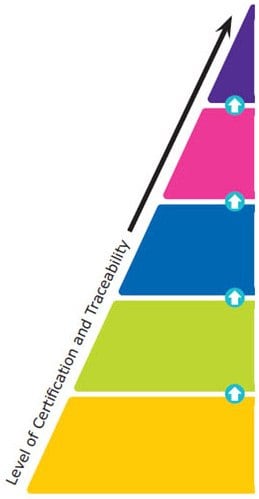Kalibracja, kwalifikacja i walidacja

Materiały referencyjne to substancje o jednorodnych i ugruntowanych wartościach jednej lub więcej właściwości. Odgrywają one istotną rolę w zapewnieniu dokładności pomiarów poprzez kalibrację metody, walidację metody pomiarowej, oszacowanie niepewności pomiaru lub przypisanie wartości do materiałów.
Są one krytycznym elementem przepływów pracy testów analitycznych i szerszych programów zapewnienia jakości. Wytwarzane zgodnie z rygorystycznymi wymogami, materiały referencyjne różnią się od innych odczynników laboratoryjnych certyfikacją i identyfikowalnością dostarczanych danych. Świat materiałów referencyjnych jest rozległy i obejmuje certyfikowane materiały referencyjne (CRM) i inne klasy jakości materiałów referencyjnych oraz koncepcje, takie jak certyfikaty analizy i identyfikowalność metrologiczna.
Nagrodzone kategorie
Łatwe oznaczanie zawartości wody w ciałach stałych, cieczach i gazach przy użyciu odczynników Aquastar®. Dokładne wyniki dzięki naszym wzorcom wody do miareczkowania.
Nasze standardy analityczne białek, peptydów i aminokwasów oferują dokładne i wiarygodne wyniki w odkrywaniu biomarkerów, badaniach farmaceutycznych, testach klinicznych i diagnostycznych, proteomice odgórnej i oddolnej oraz zastosowaniach związanych z uwierzytelnianiem żywności.
Zapoznaj się z certyfikowanymi mikrobiologicznymi materiałami referencyjnymi: VITROIDS™, krążki LENTICULE® firmy Supelco®. Idealne do testowania żywności, napojów i konopi indyjskich. Zamów już dziś.
Certyfikowane materiały referencyjne są niezbędne do dokładnego oznaczania miana w miareczkowaniu ogólnym i miareczkowaniu Karla Fischera. Są one również ważne dla dokładnej kalibracji przyrządów analitycznych, takich jak pH-metry, AAS - spektrometry absorpcji atomowej, ICP - spektroskopia plazmy sprzężonej indukcyjnie, HPLC - wysokosprawna chromatografia cieczowa, LC - chromatografia cieczowa, GC - chromatografia gazowa i IC - chromatografia jonowa.
Materiały referencyjne są krytycznym elementem przepływów pracy testów analitycznych i szerszych programów zapewnienia jakości. Są one wytwarzane zgodnie z rygorystycznymi wymaganiami i różnią się od innych odczynników laboratoryjnych certyfikacją i identyfikowalnością dostarczanych danych. Od certyfikowanych materiałów referencyjnych (CRM) i innych klas jakości materiałów referencyjnych po certyfikaty analizy, identyfikowalność metrologiczną i inne koncepcje, świat materiałów referencyjnych jest rozległy, a czasem mylący.
Materiały referencyjne są podzielone na pięć głównych kategorii w oparciu o ich klasy jakości, od krajowych norm metrologicznych i innych norm podstawowych po certyfikowane materiały referencyjne (CRM), materiały referencyjne (RM), normy analityczne i chemikalia badawcze. Wymagania dotyczące certyfikacji i identyfikowalności wzrastają z jednej klasy jakości do wyższej. Najwyższy poziom jest standaryzowany przez rządy krajowe, podczas gdy szczegółowe wytyczne ISO zapewniają standaryzację dla CRM i RM. Te wymagania ISO obejmują ISO 17034, ISO/IEC 17025 i ISO Guide 31.
Producenci materiałów referencyjnych muszą spełniać te wymagania ISO, aby produkować CRM lub RM. W przypadku certyfikowanych materiałów referencyjnych należy dostarczyć certyfikat analizy, a informacje w nim zawarte są określone przez wcześniej wspomniane wytyczne ISO. Specyfikacje jakościowe dla dwóch ostatnich poziomów są określane przez każdego niezależnego producenta, a nie przez rząd krajowy lub akredytacje ISO specyficzne dla CRM i RM.

Krajowy standard metrologiczny (np. NIST, JRC, NMI Australia)
Standard kompendialny (np. USP, EP, BP, JP, IP)
- Wydawany przez upoważniony organ
- Uważany za zapewniający najwyższy poziom dokładności i identyfikowalności<
Certyfikowany materiał referencyjny (CRM) (ISO 17034, 17025)
- Uważany za zapewniający najwyższy poziom dokładności, niepewności i identyfikowalności w odniesieniu do jednostki miary układu SI
- Wyprodukowany przez akredytowanego producenta materiałów referencyjnych
Materiał referencyjny (RM) (ISO 17034)
- Spełnia wymagania ISO, które są mniej wymagające niż w przypadku CRM
- Produkowany przez akredytowanego producenta materiałów referencyjnych
Standard analityczny (ISO 9001)
- Dostępny certyfikat analizy./li>
- Poziom certyfikacji jest różny
Reagent Grade / Research Chemical
- Mogą być dostarczane z certyfikatem analizy
- Nie są scharakteryzowane do użytku jako materiały referencyjne
Rysunek 2. Hierarchia materiałów referencyjnych - jakie są ich rodzaje?
W zależności od wymagań metody lub dostępności produktu, materiały referencyjne są stosowane w trzech różnych formatach - proszku, roztworu lub matrycy. Wybór odpowiedniego materiału referencyjnego ma kluczowe znaczenie dla zastosowań testowych laboratorium, ponieważ wyniki są tak dokładne, jak odniesienie.
Wybór materiałów referencyjnych w oparciu o cel testowania
Kwalifikacja i kalibracja przyrządów wymaga utrzymania i ustalenia ich identyfikowalności. Wybrany materiał referencyjny pomaga laboratorium osiągnąć ten cel. W codziennych rutynowych zastosowaniach związanych z przydatnością systemu ważne może być zakwalifikowanie materiału referencyjnego, który jest praktyczny i łatwy w użyciu, a jednocześnie niezawodny i opłacalny w codziennym użytkowaniu. W przypadku walidacji metod, zastosowanie wysoce dokładnych i precyzyjnych materiałów referencyjnych ma kluczowe znaczenie dla wykazania, że metoda laboratoryjna jest dokładna i precyzyjna. Do celów identyfikacji i badań przesiewowych ważne atrybuty materiałów referencyjnych obejmują potwierdzoną autentyczność i tożsamość. W zastosowaniach obejmujących kwantyfikację, testy lub ocenę stabilności wymagane są stabilne i dokładne materiały referencyjne.
| Typ testu | Użycie Ref. Mat. | Przykłady | Wymagania Ref. Materiał | |
|---|---|---|---|---|
| Kwalifikacja/Kalibracja przyrządu | Ustalenie wydajności systemu Dokładność pomiaru | Kwalifikacje roczne Rutynowe kalibracje wagi | Traceceable | |
| Rutynowa kalibracja/przydatność systemu | Codziennie/tygodniowo Specyficzne dla systemu/metody Ustalenie rutynowej wydajności | Kalibracje wagi przed użyciem Sprawdzenie wydajności systemu dla LC-UV/MS; GC-FID... | Kwalifikacja jako odpowiedni do użycia | |
| Walidacja metody | Dokładność Precyzja Swoistość & Interferencje LOD/LOQ & Liniowość | Pharma QC; Testy środowiskowe Standardy analitu(ów), interferencje, zanieczyszczenia | Dokładne Identyfikowalne | |
| Tożsamość | Porównanie nieznanego ze znanym | Nadchodzące surowce w farmacji, żywności itp. Testy przesiewowe | Autentyczność | |
| .Zawartość lub test | Ilość analitów | Pestycydy/toksyny Pharma QC - zawartość API | Certyfikuje zawartość Identyfikowalna | |
| Ocena stabilności | Monitorowanie stabilności produktu | Pharma QC | Stabilny, jednorodny | |
| Wewnętrzna kontrola jakości | Dokładność metody | Rutynowe oznaczanie ilościowe analitów - farmacja/pestycydy/diagnostyka |
Wybór odpowiednich materiałów referencyjnych może zależeć od kilku czynników, takich jak wymogi regulacyjne, dostępność, rodzaj aplikacji testowej, poziom dokładności i matryca próbki.
| Type of Test | NMI Standard | Compendial Standard | CRM | RM | norma analityczna | odczynnik chemiczny | atrybut |
|---|---|---|---|---|---|---|---|
| Intrument Qualification / Calibration | ✓ | ✓ | ✓ | Traceability & Accuracy | |||
| Routine Calibration / System Suitability | ✓ | ✓ | ✓ | ✓ | Możliwe | Kwalifikowany standard (pierwotny lub wtórny) | |
| Walidacja metody | ✓ | ✓ | ✓ | ✓ | Accuracy, Precision, Bias | ||
| Identyfikacja | ✓ | ✓ | ✓ | ✓ | ✓ | ✓ | Autentyczność |
| Zawartość lub test | ✓ | ✓ | ✓ | ✓ | Możliwe | Kwalifikowany standard | |
| Ocena stabilności | ✓ | ✓ | ✓ | ✓ | Może | Kwalifikowany Standard | |
| Wewnętrzna Kontrola Jakości | ✓ | ✓ | ✓ | ✓ | Może | Kwalifikowany standard | |
| Regulacyjny / Akredytacja | ✓ | ✓ | ✓ | ✓ | Qualified Standard |
Odwiedź naszą wyszukiwarkę dokumentów, aby znaleźć arkusze danych, certyfikaty i dokumentację techniczną.
Powiązane artykuły
- Kontrola zanieczyszczeń pierwiastkowych w produktach leczniczych za pomocą metod i materiałów analitycznych w celu zapewnienia bezpieczeństwa pacjentów.
- Materiały referencyjne, wzorce i certyfikowane materiały referencyjne mają kluczowe znaczenie dla testów analitycznych. Pomożemy Ci wybrać idealny materiał referencyjny do Twojego zastosowania, niezależnie od tego, czy używasz materiałów referencyjnych do kalibracji, czy analizy ilościowej.
- Określenie miana lub standaryzacja roztworu do miareczkowania jest niezbędna do uzyskania dokładnych i wiarygodnych wyników miareczkowania.
- Wzorce referencyjne NMR zapewniają prawidłowe działanie urządzenia. Sprawdź kluczowe parametry operacyjne tych wzorców, takie jak pw90, czułość, rozdzielczość i kształt linii.
- Wprowadzenie certyfikowanych materiałów referencyjnych 19F qNMR do certyfikacji złożonych cząsteczek.
- Zobacz wszystkie (77)
Powiązane protokoły
- Metody AOCS i AOAC do oznaczania składu kwasów tłuszczowych trans w żywności za pomocą chromatografii gazowej wymagają użycia wysoce polarnej cyjanosilikonowej kolumny kapilarnej, aby zapewnić najlepszą osiągalną rozdzielczość pików licznych izomerów geometrycznych (cis i trans) i pozycyjnych.
- Learn more about Neonicotinoids - active substances used in plant protection products to control harmful insects.
- Aldehydes and ketones are ubiquitous air pollutants. Along with esters and ethers, they are major components of indoor air pollution and are therefore important for industrial hygiene applications.
- Alkylphenols are used in various industries like paper manufacturing and pesticide formulations.
- IFRA method introduces new CRMs for allergenic fragrances, analyzed by GC with ionic liquid capillary column for selectivity.
- Zobacz wszystkie (75)
Znajdź więcej artykułów i protokołów
Jak możemy pomóc
W przypadku jakichkolwiek pytań, prosimy o przesłanie prośby o wsparcie klienta
lub rozmowę z naszym zespołem obsługi klienta:
Email [email protected]
lub zadzwoń +1 (800) 244-1173
Dodatkowe wsparcie
- Chromatogram Search
Use the Chromatogram Search to identify unknown compounds in your sample.
- Kalkulatory i aplikacje
Web Toolbox - narzędzia naukowe i zasoby dla chemii analitycznej, nauk przyrodniczych, syntezy chemicznej i materiałoznawstwa.
- Customer Support Request
Obsługa klienta, w tym pomoc przy zamówieniach, produktach, kontach i kwestiach technicznych związanych z witryną.
- FAQ
Explore our Frequently Asked Questions for answers to commonly asked questions about our products and services.
Zaloguj się lub utwórz konto, aby kontynuować.
Nie masz konta użytkownika?Dla wygody naszych klientów ta strona została przetłumaczona maszynowo. Dołożyliśmy starań, aby zapewnić dokładne tłumaczenie maszynowe. Tłumaczenie maszynowe nie jest jednak doskonałe. Jeśli tłumaczenie maszynowe nie spełnia Twoich oczekiwań, przejdź do wersji w języku angielskim.











